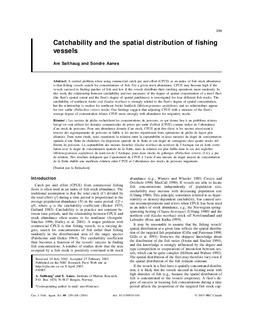| dc.contributor.author | Salthaug, Are | |
| dc.contributor.author | Aanes, Sondre | |
| dc.date.accessioned | 2007-06-06T11:45:10Z | |
| dc.date.issued | 2003 | |
| dc.identifier.issn | 0706-652X | |
| dc.identifier.uri | http://hdl.handle.net/11250/108840 | |
| dc.description.abstract | A central problem when using commercial catch per unit effort (CPUE) as an index of fish stock abundance
is that fishing vessels search for concentrations of fish. For a given stock abundance, CPUE may become high if the
vessels succeed in finding patches of fish and low if the vessels distribute their catching operations more randomly. In
this work, the relationship between catchability and two measures of the degree of spatial concentration of a trawl fleet
(the fleet’s spatial extent and the fleet’s degree of spatial patchiness) is investigated for four different fish stocks. The
catchability of northeast Arctic cod (Gadus morhua) is strongly related to the fleet’s degree of spatial concentration,
but the relationship is weaker for northeast Arctic haddock (Melanogrammus aeglefinus), and no relationships appear
for two saithe (Pollachius virens) stocks. Our findings suggest that adjusting CPUE with a measure of the fleet’s
average degree of concentration relates CPUE more strongly with abundance for migratory stocks. | en |
| dc.format.extent | 440706 bytes | |
| dc.format.mimetype | application/pdf | |
| dc.language.iso | eng | en |
| dc.subject | cod | en |
| dc.subject | torsk | en |
| dc.title | Catchability and the spatial distribution of fishing vessels | en |
| dc.type | Journal article | en |
| dc.type | Peer reviewed | |
| dc.source.pagenumber | 259-268 | en |
| dc.source.volume | 60 | en |
| dc.source.journal | Canadian Journal of Fisheries and Aquatic Sciences | en |
| dc.source.issue | 3 | |
| dc.identifier.doi | http://dx.doi.org/10.1139/F03-018 | |
